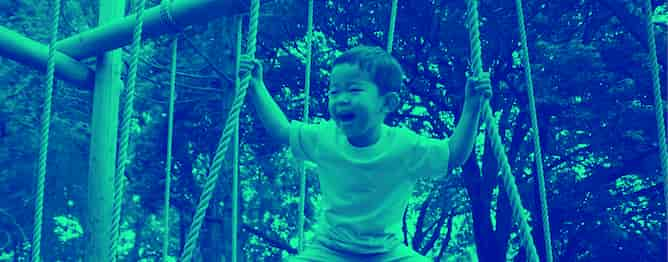By Lindsay Barrett
We all want our kids to learn what they need to be successful. But guess what most kids want to do? Play! And let’s face it: we adults want to play, too.
But learning and playtime can, and should, happily overlap. A growing body of research highlights the many benefits of open-ended play activities like building, pretending, creating, and just getting all-around messy for kids. Doctors, according to an article published by the American Academy of Pediatrics, even “prescribe” play to support healthy physical, emotional, and intellectual development in children.
Play experiences are prime contexts for building literacy skills in reading, writing, and language, not to mention math and science knowledge, social and emotional skills, motor skills, and plenty more. Mr. Rogers put it perfectly: “Play is often talked about as if it were a relief from serious learning, but for children, play is serious learning.”
Language, of course, is the basis of literacy learning, and imaginative play is absolutely full of language. Conversations during playtime include both social-emotional vocabulary we use when giving directions, talking about feelings, and working through conflicts, as well as more specialized vocabulary related to the play context.
How playtime can be meaningful for the whole family
The play suggestions below are easily adaptable for toddlers through elementary school kiddos. In families, play can be the great equalizer. Older and younger siblings can join in ways that fit their development (and stave off the inevitable squabbling). Play bakeries, for instance, need someone to make the signs and someone to chat cheerfully with customers. Play grocery stores are fit for both shoppers consulting a specific list—and let’s not leave out those more impulsive fill-the-basket-with-everything-that-looks-yummy buyers.
Play scenarios can range from simple and repetitive to extensively detailed. You can always find play materials if you’re willing to use your imagination. We’ve all seen kids play happily for hours with nothing more than a cardboard box.
So, let’s play on! Here are some tried-and-true ideas that will get kids reading, writing, and talking up a (pretend) storm.
Playtime activities that build literacy skills
Set up a restaurant
Go generic with whatever play food you have on hand, or create a favorite food item like cardboard pizza, felt burritos, or ice cream cones made of toilet tubes and crumpled balls of tissue paper. You’ll need signs, menus, notepads for taking orders, and maybe even customer comment cards. Pull out all the stops when a restaurant reviewer comes to dine!
Open a store
Whether it’s a supermarket stocked with food packages from your recycling pile, a gift store that sells trinkets gathered from around the house, or even a book or toy store, it’ll need a sign and for its wares to be organized into labeled sections. Shoppers should bring their lists.
If you get tired of the usual store types, one fun twist is to open up a shoe store. Measure customers’ feet, write down their sizes, and check the stockroom. Are the shoes too loose, tight, squeaky, or stiff? Talk about the attributes of each pair of shoes to build vocabulary.
Hide pirate treasure
Ahoy, matey! Decorate a treasure box, load it with gold coins, and draw a map to remember where it’s buried. Sing some rhyming sea chanteys as you head out on your next voyage. When you’re ready for someone to retrieve the treasure, write cryptic clues to help them find it.
Be first responders
Calling all fire fighters, police officers, and paramedics! Staff your dispatcher’s desk with a phone and materials for writing down emergencies and incident reports, and include a town map for reference. Send out your cardboard box vehicles to do their heroic, life-saving duties.
Staff a busy doctor’s office
Stuffed animals feeling ill? Make sure you keep a list of everyone’s ailments and appointment times to stay on schedule. Take notes on their treatment plans and send them home with the right prescription.
Curate a captivating museum
Whether it showcases art, dinosaurs, inventions, beach treasures, or LEGO creations, all good museums need informative signage and a knowledgeable docent. When school groups come on field trips, be sure to give them engaging assignments.
Play can be full of reading and writing, too. Lists, signs, notes, plans, recipes, receipts, reports—all of these boost kids’ engagement with play scenarios, and give authentic reasons for them to flex their growing literacy muscles. (Don’t worry: we won’t tell your kids that there’s some learning sneaked into their fun.)
Build a block town
Actually, any building toys are fair game, here. Set up streets, buildings, and homes, and add sticky note signs. Drive toy cars down the main thoroughfare and have the driver ask how to find different locations to get kids practicing giving and following directions in sequence.
Work on a construction site
Provide a set of plans for the foreman and map out an efficient building schedule. There are plenty of supporting roles to play, like the electrician, plumber, painter, and building inspector. Plus, for vocabulary expansion, kids will need to be able to tell their beams from their posts, and check their structures for stability.
Send letters at the post office
Paint a cardboard-box mailbox and stock plenty of paper, notecards, envelopes, and writing implements. Write notes, cards or invitations, address the envelopes, and deliver them to the appropriate family member to read—or tote them out to the actual mailbox to send them further afield.
Build an obstacle course
Indoors or out, use simple props to create obstacles for jumping, climbing, crawling, side-stepping, and balancing. Mark each obstacle with a catchy name and post directions on how to complete it. Keep a running leader board of participants’ times.
Feed the zoo animals
Use cardboard boxes, large plastic food storage containers, or even laundry baskets to create cages and tanks for stuffed animals. Arrange the animals into sections, create signs and a map, and post a schedule of feeding times and special presentations. Be sure to research any questions that arise about specific animals’ diets and other needs.
To boost vocabulary, give your pretend zoo, for example, a reptile house and a marsupial section.
Take a trip without leaving the house
Plan that dream vacation by making travel brochures and booking airline tickets. Pack bags and set up a pretend airplane from chairs or pillows. Upon arrival, take in all the sights and don’t forget to write a postcard home!
Get messy in a mud kitchen
A mud kitchen is a gloriously dirty outdoor play kitchen. All you need is a surface—an old table or even a large stump work fine—and a few old pots, pans, and utensils. The earth is your grocery store. Take orders and cook up concoctions of dirt, water, leaves and pine needles, perhaps with a flower or acorn garnish. Photograph favorite creations and author a Mud Kitchen Cookbook.
Join the circus
Round up your best human, pet, or stuffed animal performers, and make sure you do plenty of advertising for your show to boost ticket sales. The ringmaster will need plenty of riveting details and crowd-pleasing quips written into their script, too.
Host a night at the theater
Acting out stories is amazing for building reading comprehension and literary language skills. Choose a favorite title and rehearse a retelling with stuffed animal, puppet, or human actors. Sell tickets and perform for the crowd.
Don’t feel like you’re “wasting” time kids could be learning by letting them play. Embrace play and harness its inherent educational power by asking questions and making suggestions. Heck, just go ahead and play along, too.
Lindsay Barrett is a teacher and literacy consultant. She writes resources for educators and parents. Find out more about her work at lindsay-barrett.com.



















